Kobukusa Origins
A ko-buku-sa, 古帛紗, old-cloth-gauze, is used to support a cha-wan, 茶碗, tea-bowl, and to display a fine object. As its name indicates, the kobukusa is an old fukusa, which is a larger square of silk fabric used by the teishu to purify certain Tea utensils. The kobukusa is not square, which is the same for the fukusa. What is the reason for this?
A person at a Tea gathering ought to have their own kobukusa together with a fuku-sa, 帛紗, cloth-gauze, and kai-shi, 懐紙, heart-paper. It is closely associated with tatami, because the kobukusa is often placed on tatami. Perhaps there is a connection between the measurements of the kobukusa and the size of tatami, as there are two predominant sizes of tatami: Kyō-ma 25 x 50 sun kujira-jaku and chū-Kyō-ma 30 x 60 sun kane-jaku.
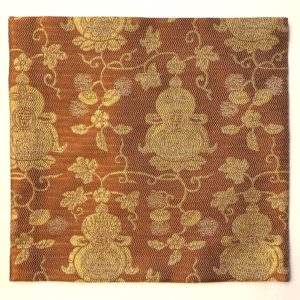
Tokusai, masters of fabrics for Chanoyu, determines measurements of the kobukusa at 4 x 4.2 (? 4.1666 to infinity?) sun kujira-jaku or 5 x 5.2 sun kane-jaku.The width of the kobukusa, 4 sun kujira-jaku equals 5 sun kane-jaku. 5 sun is one/sixth the width of chū-Kyō tatami. The width of a chū-Kyō tatami is equal to 6 kobukusa widths.
Kai-chū ko-buku-sa, 懐中古帛紗, heart-middle old-cloth-gauze, is folded in half, and kept in the front folding of the kimono.
The length of the kobukusa 4.2 is nearly equal to one/sixth the width of Kyō tatami. 25 sun kujira-jaku. 25 divided by six equals 4,1666 to infinity.
It is my nature to measure and compare chadōgu. Very recently, when preparing for teaching Wakin Date, I wondered, as I have for many years, why the ko-buku-sa, 古帛紗, old-cloth-gauze is not square. The fukusa is not square, because the one by two shaku fabric is folded in half and hemmed on three sides. The kobukusa seems not to follow that concept.
A kobukusa is for supporting a chawan, and displaying an object. Because it is closely associated with tatami, perhaps there is a connection between the measurements of the kobukusa and the size of tatami. There are two predominant sizes of tatami: Kyō-ma, 京間, Capital-room, 25 x 50 sun kujira-jaku and chū-Kyō-ma, 中京間, mid-Capital-room, 3 x 6 shaku kane-jaku, or 30 x 60 sun kane-jaku.
The number 6, roku, 六, is symbolic of Infinity in Time, and is identified with Water. The kobukusa has four corners, and is folded in half, which implies the number 8, hachi, 八, which is symbolic of Infinity in Space.
In a Tea presentation that uses the kobukusa to purify certain utensils, the kobukusa is folded into sixteenths.
The measurements of the Kyō tatami, 2.5 x 5 shaku kujira-jaku, are odd numbers which are identified as Yō, 陽, positive, because they cannot be divided equally in half. The measurements of chū-Kyō, 3 x 6 shaku kane-jaku are even numbers which are identified as In, 陰, negative, because they can be divided equally in half. Therefore, Kyō tatami are classified as Yō, and chū-Kyō tatami are classified as In. The same can be true with a the kobukusa: the width of the kobukusa.
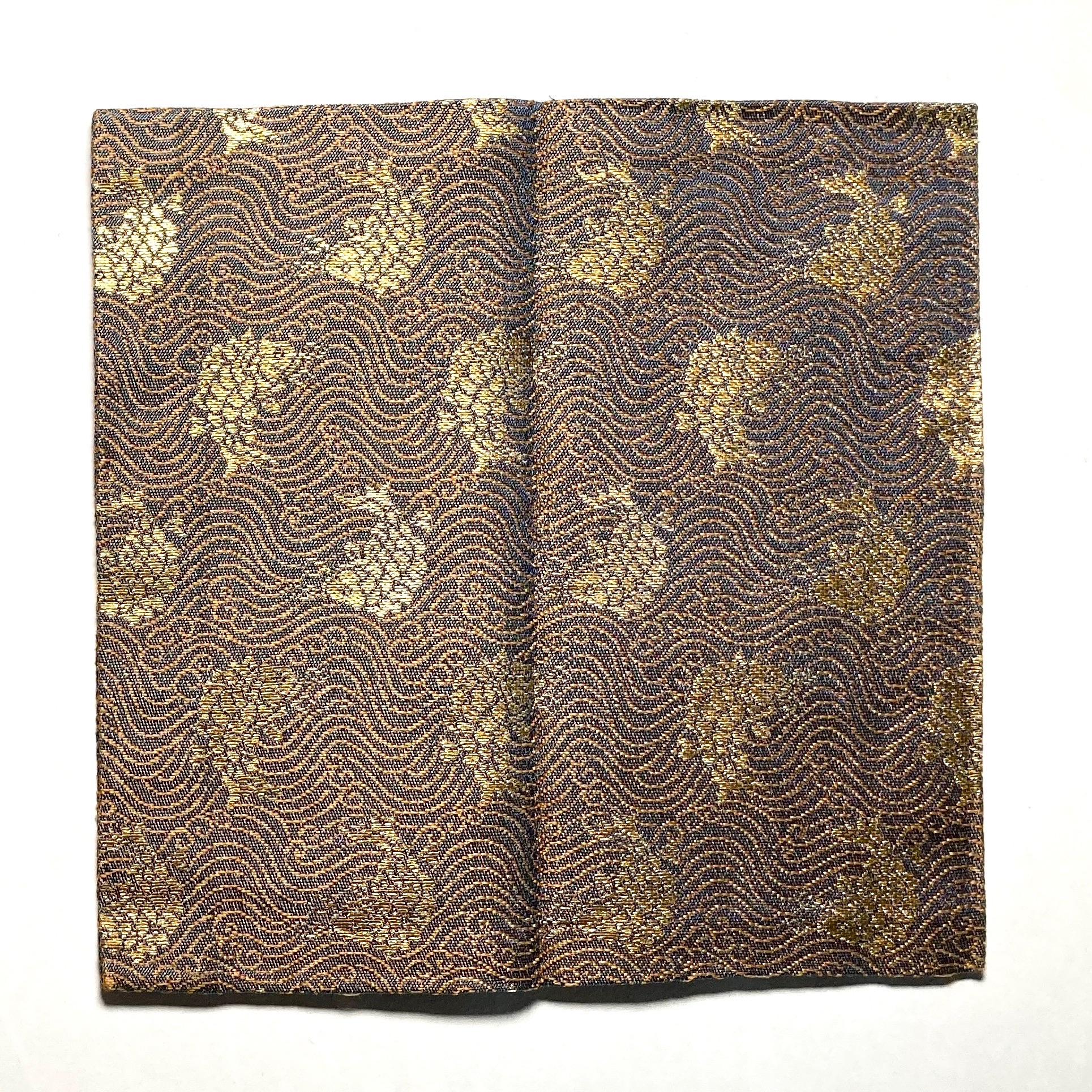
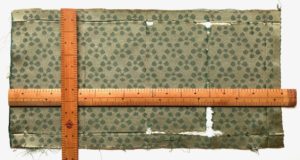
Kobukusa, Arai-so Kin-ran, 荒磯金襴, Rough-shore, – 4.2 x 4 sun kujira-jaku; Tatsumura, Co. Kobukusa, Rikyū-bai don-su, 利休梅緞子, Rikyū-prunus damask-of, fabric opened flat – 9.5 sun kujira-jaku x 6 sun kane-jaku. Note that both shaku were used to measure the kobukusa.
From the evidence, it appears that the full length of the opened fabric, 9.5 is made with kujira-jaku: weavers traditionally use the kujira-jaku to make measurements. The hems at of the length of the fabric are 5 bu kujira-jaku. The narrow width of the open fabric measures 5.8 sun kujira-jaku, or as indicated in the picture, 6 sun kane-jaku. The hems of the long sides are 5 bu kane-jaku. From these measurements it appears that the length is made with kujira-jaku, and the width is made with kane-jaku. It is curious to note that the all the hems are not the same physical measurement, although they are numerically 5 bu. The green kobukusa was used for decades, to remind me of the efforts shared by many people at Kō-shū-kai, 講習会, Lecture-learn-meeting, 50 plus years ago, and I still learn from it. After further comparisons, I found that the width of Kyō-tatami is equal to six 4.2 kobukusa placed side by side. Also, the width of chū-Kyō-tatami is equal to six 4-sun kujira-jaku kobukusa, or rather six 5 sun kane-jaku kobukusa.
There are those who believe that there is no relevance to the use of the kujira-jaku, and that only the kane-jaku is used. The utensils for Chanoyu prove that both shaku were and are used. Much of the numerical significance of Chadōgu and their symbolism can be lost. After years of measuring things, I was shocked, only several year ago, when I realized that Kyō-tatami were measured, not with kane-jaku, like chū-Kyō-tatami 3 x 6 shaku kane-jaku, but with kujira-jaku, 2.5 x 5 shaku kujira-jaku. In certain instances, the kobukusa can be used to determine measurements using both kujira-jaku and kane-jaku.
The full length of the open kobukusa fabric is 9.5 sun kujira-jaku. The number 9.5 is found throughout chadōgu: the standard fukusa measures 9.5 x 9 sun kane-jaku; the length of hibashi is 9.5 sun kane-jaku.
Perhaps by coincidence, the diagonal measurement of the kobukusa, 4.2 x 4 sun kujira-jaku, is 5.8 sun. Both numbers 5 and 8 are highly symbolic. Transposed to kane-jaku, the diagonal measurement is 7.25 sun kane-jaku. This is close to 7 sun, which is a measurement that is widely prevalent in Chanoyu.
The fabric of the pictured green kobukusa includes the selvage, self-edge, with the other three edges that are cut. Some fabrics, such as the cloth for chakin, are woven so that the edges along the sides are both selvages, and only two edges are cut and hemmed. The fabric is woven the width of the fabric.
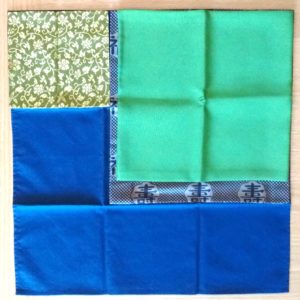
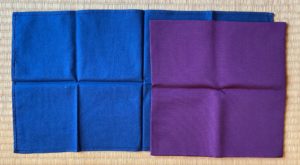


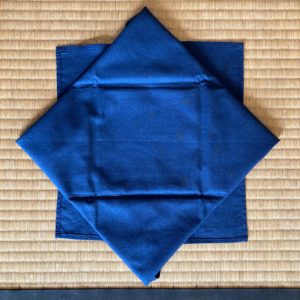
When preparing to eat a Buddhist meal, the blue fukusa is laid diagonally, and the corners tucked under to create an 8-cornered mat, that is emblematic of Infinity in Space. The fukusa is 45cm square. Questions arise as to the intended measurement in shaku, kane or kujira.
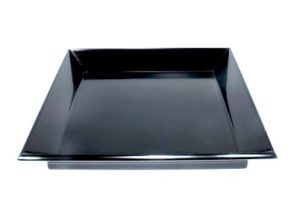
When presenting koi-cha, 濃茶, thick-tea, in a cha-wan, 茶碗, tea-bowl, that is not Raku yaki, 楽焼, Pleasure fired, a kobukusa is offered with the bowl. A kobukusa is not traditionally offered to the guests when the chawan is made of Raku yaki. When presenting koi-cha, 濃茶, thick-tea, in a Ten-moku, 天目, Heaven-eye, chawan, the bowl is placed on a dai, 台, support, when it is offered to the guests. The Tenmoku chawan is placed on each guest’s own kobukusa when drinking the tea. In a very high Tea presentation, the teishu places the Tenmoku chawan on a kobukusa on the dai. The guest drinks the tea with the chawan on the kobukusa. In highly formal Tea presentations, when the dai is being purified, the Tenmoku chawan is placed on the ji-ita, 地板, earth-board, of the dai-su, 台子, support-of, or on a kobukusa, as the chawan should not be placed directly on the tatami/floor.
One exception is when offering koicha to a ki-nin, 貴人, noble-person. The chawan is often modeled on the Tenmoku chawan, and is offered on a dai that is also modeled on the dai of the Tenmoku. A kobukusa is not used to support the chawan. In addition, the kinin chawan is usually not made of Raku, so that it ought to be placed on a kobukusa. Questions may arise as to the reason why a kobukusa is not used.
Kobukusa measurement of 5 sun kane-jaku may have some connection with the five aspects associated with the dai-Tenmoku chawan. These would be the Go-rin, 五輪, Five-rings, the five principles, and the Go-gyō, 五行 , Five-transitions, the five physical elements.
, Five-transitions, the five physical elements.
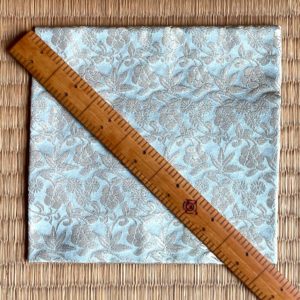
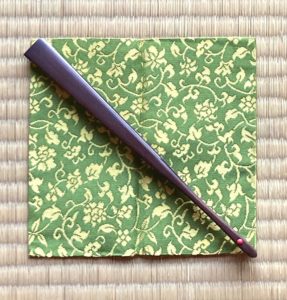
Left: pale blue and silver thread kobukusa with a pattern of shō-chiku-bai, 松竹梅, pine-bamboo-prunus, and kane-jaku ruler. Kobukusa 5 x 5.5 sun kane-jaku, diagonal is 7.25 sun kane-jaku. The kobukusa can be used to approximate 7 sun kane-jaku when determining the location of utensils, etc. A traditional Japanese kujira-jaku ruler measurement of the kobukusa is 4 x 4.2 sun kujira-jaku, which creates a diagonal measurement of 5.8 sun kujira-jaku. The measurement transposed is 7.25 sun kane-jaku, which is close to 7 sun kane-jaku, a standard measurement in Chanoyu. Right: green and gold thread kobukusa with a pattern bo-tan Kara-kusa, 牡丹唐草, male-rust red (peony) Tang-grass. The kobukusa on the right has a sen-su, 扇子, fan-of, with a length of 7 sun kane-jaku, that is just short of the diagonal of the kobukusa.
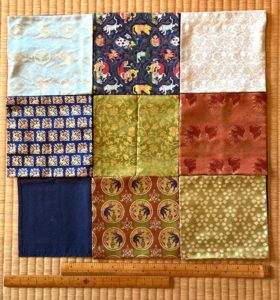
There appears to be a close relationship between the kobukusa and the Buddhist fukusa. Pictured above are 8 kobukusa laid over a Buddhist fukusa. The widths of three kobukusa are equal to the width of the fukusa. The horizontal lengths of the kobukusa are greater than the length of the fukusa. The additional length of the kobukusa is equal to the widths of the three kobukusa. Both of the shaku rulers, kane and kujira, pictured at the bottom help to understand the measurements of the kobukusa.
For further study, see also: Kobukusa, Kobukusa Picture Gallery, Shaku Measurements

